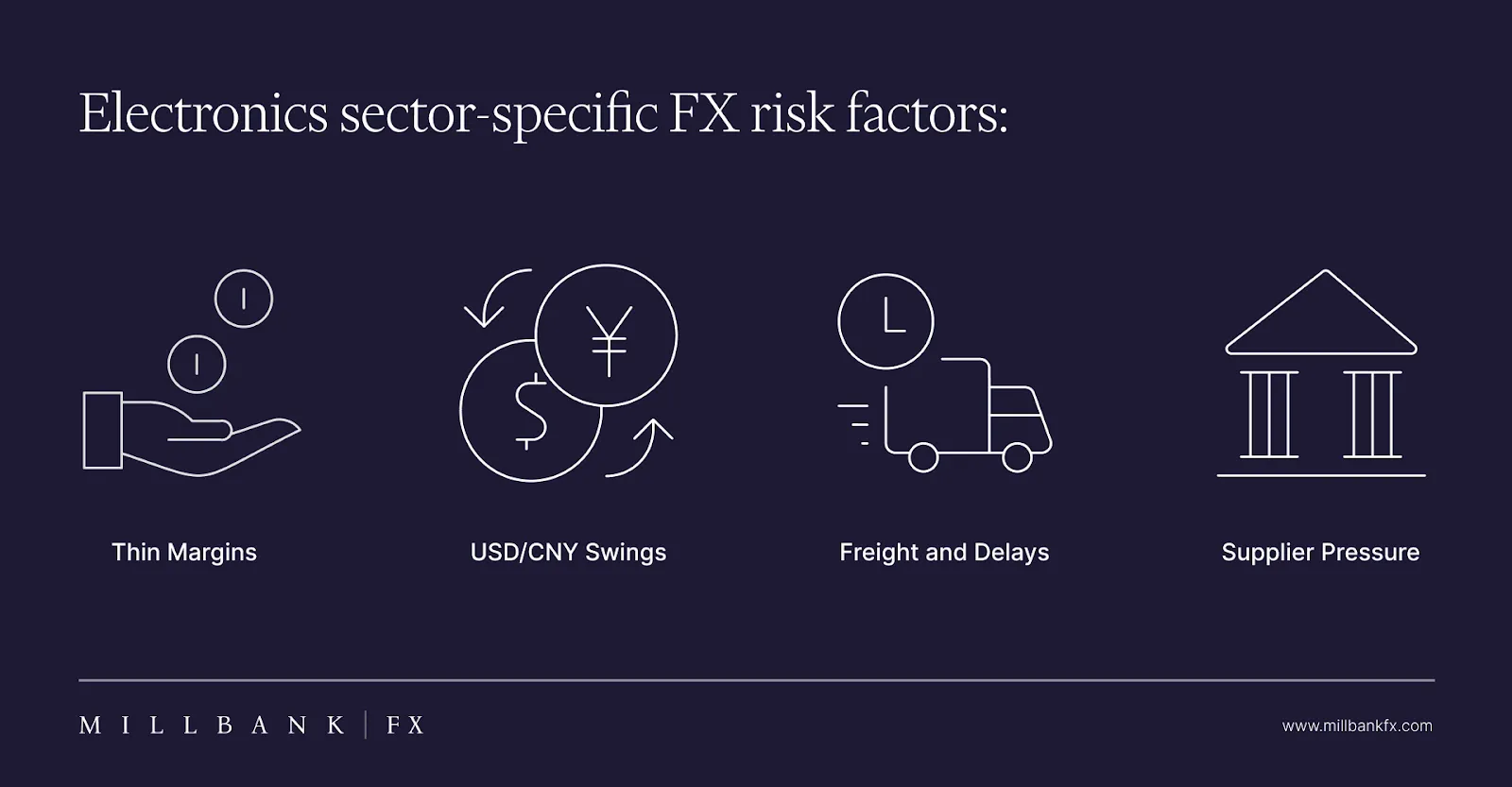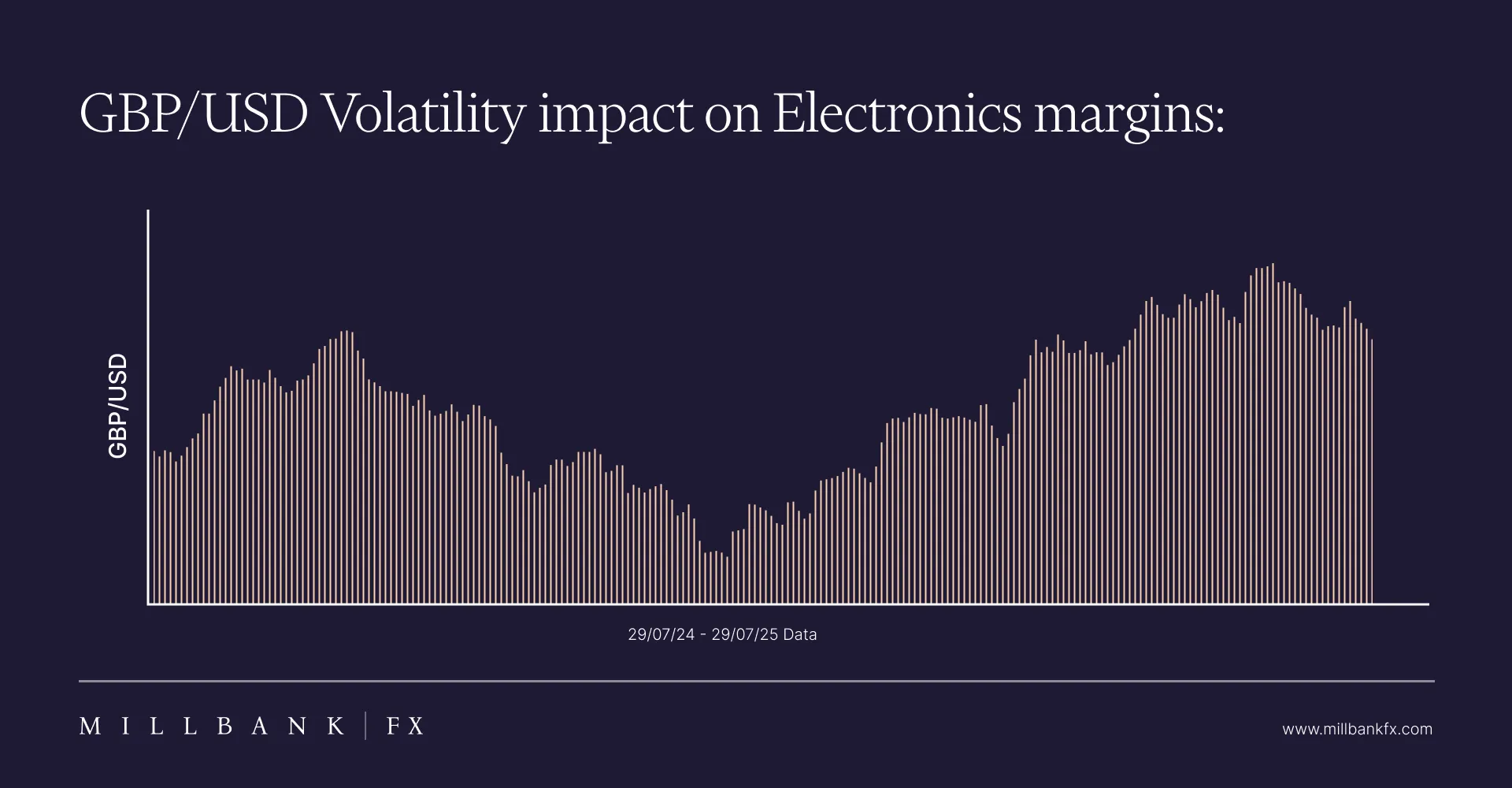英国の電子機器輸入セクターは、急速なイノベーション、限られた利益、複雑なグローバルサプライチェーンの影響を受けていることが特徴です。効果的な外国為替(FX)リスク管理はもはや選択肢ではありません。米ドル/人民元のボラティリティ、サプライヤー条件の変化、予測不可能な輸送コストに悩まされることが多い業界では、競争力とマージンを維持することが不可欠です。このガイドでは、英国の電子機器輸入業者と調達ファイナンスチームが直面している商業FXリスクを探り、セクターのニーズに合わせた実行可能な戦略とミルバンクのFXソリューションについて概説します。
英国の電子機器輸入:FXチャレンジ
英国の電子機器輸入業者は、定期的に米ドル(USD)、中国元(CNY)、ユーロ(EUR)で部品や完成品を購入し、英ポンド(GBP)やその他のヨーロッパ市場に販売しています。利益率が圧迫されることが多く(2 ~ 5% という低い場合もあります)、わずかな通貨変動でも収益が大幅に低下したり、実行可能な出荷が損失に変わったりする可能性があります。
150万ポンドで、純利益が 3% と予想される貨物を考えてみましょう。GBP/USDが 2% 不利な動きをすると、30,000ポンド(マージン全額になる可能性がある)が露出することになります。変動の激しいスポットレート、支払い遅延、輸送遅延リスクと相まって、FXリスク管理は、事後対応型ではなく、積極的かつ強固でなければなりません。
セクター固有のFXリスク要因
- 薄いマージン: 電子機器の売上高が高く、価格競争が激しいため、ミスを犯す余地はほとんどありません。FXリスクが保護されていないと、利益が完全に失われる可能性があります。
- 米ドル/人民元スイング: 主要な上流コストは、多くの場合、米ドルまたは中国元で価格設定されます。関税の変更、地政学的な緊張、中央銀行の政策の変化により、短期的および長期的なボラティリティが高まる可能性があります。
- 貨物と遅延: 電子部品を海外に発送すると遅延が発生します。請求から支払いまでの間には、通貨レートの変動によりさらに予測不能な状況が生じます。
- サプライヤーの圧力: 通貨決済の前に供給契約の再交渉や注文量の変更が常に可能であるとは限らず、エクスポージャーのリスクが高まります。

電子機器輸入業者向けの戦略的FXリスク管理ツール
FXリスク管理の成功は、政策規律、市場認識、適切な金融商品の使用の組み合わせに基づいています。英国の電子系財務マネージャーにとって、主な戦略には以下が含まれます。
1。通貨ネッティングとナチュラルヘッジング
可能であれば、流入キャッシュフローと流出キャッシュフローを同じ通貨で調整してください。たとえば、サプライヤーへの支払いと一部の顧客領収書の両方が米ドル建ての場合、これらは当然互いに相殺され、換算が必要な正味金額が減少します。このアプローチは、金融商品を追加しなくても、短期的な通貨変動によるマージンを緩和するのに役立ちます。
2。スポット取引
現物FX取引は、現在の市場レートで通貨を両替するため、直前でのチャージや小口輸入など、即時または予測不可能な支払いニーズに適しています。ただし、サプライヤーの請求サイクル中に市場レートが急激に変動した場合、スポットのみに依存するとコストが増大する可能性があります。
3。先渡契約
先渡契約により、輸入者は特定の通貨ペアのフォワードレートを将来の決済用に確保できるため、予算編成とマージン保護の確実性が高まります。先渡契約は拘束力のあるデリバティブであり、金利がお客様に不利に動いた場合、担保が必要になることがあります。通常、出荷スケジュールや季節ごとの在庫補充サイクルに合わせて、数量が確定していて決済日がわかっている注文には、この方法が推奨されます。
4。通貨オプション
オプションには、あらかじめ設定されたレートで通貨を交換する権利がありますが、義務はありません。オプションは市場が好調に動いたり予期せぬ動きをしたりする場合に柔軟に対応できますが(新たな関税リスクなど)、初期費用と複雑さを考えると、一般的にコストが高く、中小企業にはあまり適していません。
5。フレキシブルな支払いソリューション
仮想通貨ウォレットや多通貨口座などのソリューションは、支払いの受け取りと出金を合理化し、費用のかかる臨時両替の必要性を減らし、希望する通貨での支払いを可能にすることでサプライヤーとの関係を改善するのに役立ちます。

ケーススタディの例:英国の電子機器輸入業者のFX管理
英国の中規模輸入業者であるXYZ Componentsは、2024年第1四半期に米ドル/英ポンドが変動したため、継続的なマージンリークに直面しました。同社は、先渡契約を使用して最大の米ドル建て貨物のレートを確保し、少量の流入については通貨ネッティングという明確なFXポリシーを実施することで、年間のFXコストの変動を 40% 以上削減しました。また、予測可能な支払いサイクルによってサプライヤーの交渉力も向上し、XYZ社のサプライチェーンの安定性と市場競争力が高まりました。
実践的なFXポリシーの構築
財務リーダーは、以下を含む明確なFXリスク管理方針を文書化する必要があります。
- 外貨リスクの定期的な予測(通貨および期間別)
- 主要な請求書タイプまたはサプライヤー条件に使用する手段と戦略の定義
- フォワードとスポットまたはオプションの使用基準値(例:50,000ポンドを超える契約、またはリードタイムが3か月を超える契約の方がフォワードの方が適している場合があります)
- 過去の為替レートの変動に対する定期的なレビューとストレステスト
Millbank FX: セクターの専門知識とプラットフォームのメリット
私たちは、マージン圧力と頻繁な米ドル/人民元のエクスポージャーの下で事業を行っている英国の電子機器輸入業者をサポートすることを専門としています。当社のサービスには以下が含まれます。
- 経験豊富な FX ディーラーによるパーソナルサポート — 自動化された非人格的なシステムには依存しません
- 市場競争力のある料金と透明性の高い先行価格設定により、正確な原価計算と見積りに役立つ
- 電子機器に合わせた効率的なオンボーディングとコンプライアンスにより、フォワードレートの確保と数時間以内の取引が可能
- 電子機器の出荷サイクルに合わせた柔軟な決済期間と支払い条件
最も重要なのは、お客様が最も適切なリスク管理手段を選択できるように支援することで、マージンの確実性を優先し、お客様が不適切または高価なソリューションに追い込まれることは決してありません。
エレクトロニクスFX管理における典型的な間違い
- FX決定の遅延: 請求書の期日まで待つと、フォワードレートを確保したり、マージンの低下を防ぐことができなくなります。
- 露出の視認性が悪い: 通貨決済の規模やタイミングを過小評価すると、自然なヘッジの機会を逃すことになります。
- 複雑な製品への過剰支出: オプションや複雑なデリバティブは魅力的かもしれませんが、そのコストが、リピートエクスポージャーを伴う大規模事業を行う企業に適していることはめったにありません。
- サプライヤーとの対話を無視する: サプライヤーと協力して代替通貨での支払いを受け付けたり、請求書をずらしたりすることで、一方的なリスクを大幅に減らすことができます。
次のステップ:為替変動に対するエレクトロニクス事業の強化
現在のグローバル市場では、統制のとれたFX戦略は、英国の電子機器輸入セクターの収益性の高い成長の基本です。通貨ネッティング、先渡契約、専門家によるサポートを適切に組み合わせることで、ドル、人民元、または輸送路がどのように動いても、ビジネスのマージンを支え、予測できないコストを抑え、競争力を維持することができます。




